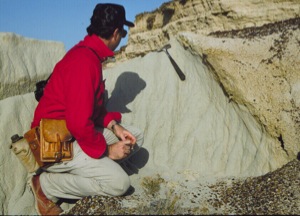
Structure 1

The strata of the northern Great Plains are generally considered to lack structure. The main question that you will attempt to resolve through your field study is whether the arrangements of strata in the Little Badlands are tectonically deformed. The Paleogene and Neogene strata are prone to slumping but can all the structures be attributed to slumping? You need to think about criteria that you might use to distinguish slumps and faults.
High angle contact in the Golden Valley Formation truncated by colluvium. Does this structure represent a fault or a paleoslump?
(Photo Allan Ashworth)

How would you describe this structure if you determined it to be tectonically formed?
(Photo Allan Ashworth)

Difference in lithology can be traced on the ground. They can sometimes be picked out by plants which prefer some lithologies over others because of their different water holding capacities. What aspect of a structure does a compass bearing of this boundary represent?
(Photo Allan Ashworth)

Look for boundaries of the type in this photograph. When you find them you will need to measure dip and strike of the plane of the structure.
(Photo Allan Ashworth)

Fault or slump planes can be exposed and their surfaces examined for polishing and striations. Measurements of striations relative to the dip of the plane of the structure provide evidence of rotation and are important in helping to determine stress relationships.
(Photo Allan Ashworth)
Acknowledgment: Web site and course info based on material developed by Allan Ashworth